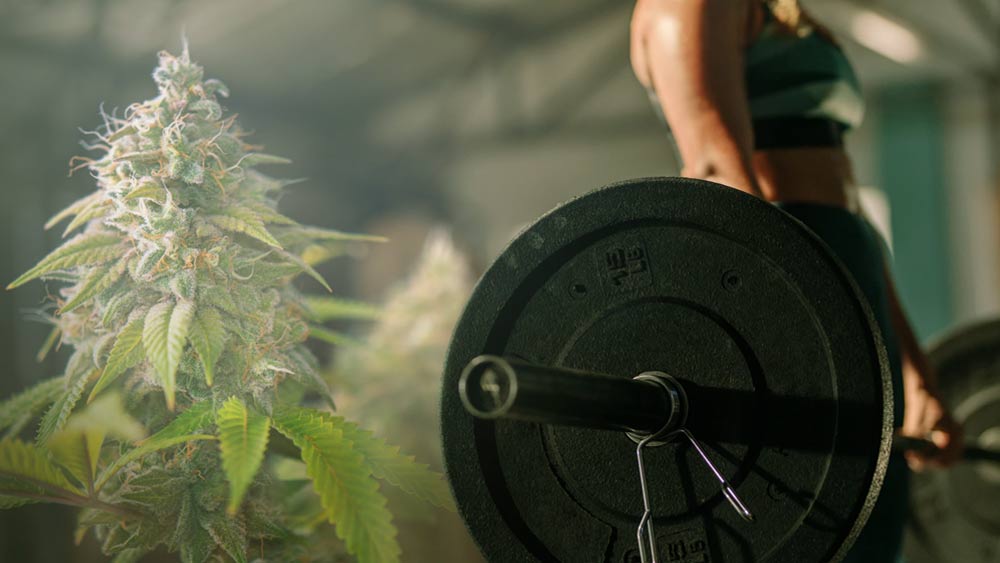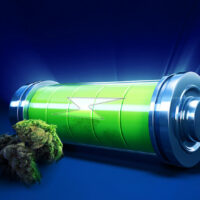The psychoactive – and physical properties – of THC and CBD can be a boon for people looking to get more fit by hefting some iron. But only if you know what you’re doing.
Through a lens, darkly
Blame the omnipresent reach of social media. Blame a plethora of chiselled Instagram models. Blame a culture in which the media creates an expectation that beautiful bodies are what we should perpetually be working toward.
Many factors can shoulder responsibility for one clear fact: in 2020, many more of us are thinking about changing our bodies than ever before.
This increased focus on our physical appearance wrought by the omnipresent lens of social media is probably not an ideal way for us to connect with a healthy understanding of body image.
So, if you were to try to pull a positive message out from the morass of conflicting messages about body image you might find online, you could do worse than this one: no matter who you are, and no matter what your body looks like, it makes sense to make a regular exercise regime a part of your daily life.
Regular, vigorous exercise at any stage in life has been shown to confer numerous health benefits, from improved cardiovascular performance to better sleep to improved immune function.
As many people are realizing, regular weight training is a very efficient and beneficial way to add a serious dose of fitness to your life.
Social media vs. reality
I started weight training for real about four years ago. Prior to then, fitness had always taken the place of a peripheral element in my life. I never assigned it as much importance as work or being able to eat whatever I wanted when I wanted.
However, as the years progressed, and as the diameter of my waistline increased, I realized my mistake in not assigning fitness a more important role.
The final straw came when I emerged from a certain double-arched fast food outlet, noticing my fatty vestigial protuberance emerged from the doors well before I did.
Weight training delivers great bang for your physical fitness buck. When you heft some iron, what you’re essentially doing is burning off fat tissue, which basically just sits there, replacing it with muscle fibre, which does work and is hungry for energy.
Thus, to a certain degree, the more you lift, the leaner and hungrier you get. It’s like you’re in a swole-inducing positive feedback loop.
What’s behind weightlifting?
Most successful weightlifters are focussed on one thing only: getting their muscles to do a very specific type of physical work in a way that applies tension evenly along the entire range of motion of the exercise.
Fortunately, as we’ll discover shortly, cannabis is an ideal tool to help you achieve the focus necessary to accomplish this.
There’s plenty of jargon that gets thrown around amongst weightlifters. If you’re a new recruit (which can be intimidating – but there are many spaces where you are likely to feel more welcome) you can pretty much ignore most of it, except for two keyterms:
- Rep: one complete cycle of movement through an exercise (one pushup, one bench press, etc), from starting position to starting position
- Set: a circuit consisting of a certain number of reps of a particular exercise
Therefore, if you were to perform 4 sets of 12 reps of squats, you would perform 4 consecutive groups of 12 squats, for a total of 48 squats. It is typical to rest between sets.
Optimizing sets and reps
There are a fair number of techniques out there for optimizing your sets and reps.
Doing more sets and reps at a lower weight (as opposed to less reps and more weight) falls under an exercise philosophy known as German Volume Training.
The idea is that by prolonging the number of sets done, the muscle fibre is working for a longer time, increasing its metabolic output.
This makes the tissue stronger and able to complete more work, meaning a stronger you. If you perform high-rep exercises for a prolonged period of time, you can expect to see a real increase in muscle size.
One challenge that many bodybuilders face is maintaining a cohesive sense of focus when they are trying to complete German Volume Training-style sets.
In order to gain a maximum amount of benefit, it’s important to really focus on completing each rep in a full, consistent and repeatable way so the muscle fibres are able to move through the maximum range of motion, which confers the greatest amount of benefit.
But it’s a hard sell indeed to be able to maintain complete focus over one particular rep when that exercise may be one out of 500 repetitions for the day.
Mind-muscle connection
Have you ever slogged your way through a workout where it simply seemed like you were on autopilot? Where you logged 20 reps of a particular exercise without any recollection of what it is you did and how you got it done?
You may have worked out your body, but you did it without engaging your mind. Thus, some percentage of your efforts were likely wasted because you did not engage your muscles over the full range of motion.
This is where the mind-muscle connection comes into play.
It’s known that each muscle fibre has more than one connection to the network of synaptic cells that govern muscle contraction, with those signals originating in the brain and spinal cord.
The more frequently you are able to use a particular muscle fibre, the stronger the connections between that fibre and your brain become.
This is the basis of the mind-muscle connection: either use it and strengthen it… or lose it.
So what’s the best way to improve the mind-muscle connection so we can take full advantage of every rep? Many amateur athletes are turning to cannabis to help.
Despite a number of recent legal changes in many parts of the world that have made cannabis either completely legal or decriminalized to some extent, marijuana has a fairly sketchy reputation in both the amateur and professional sporting worlds.
Cannabis is flat-out banned in many pro and amateur-level leagues and other sporting bodies can hand out strict penalties if players are found to be using marijuana.
Cannabis: A portal to “the zone”
But many athletes who puff and work out/compete do so because they claim cannabis gets them into “the zone” and provides them with a deep connection between their minds and their bodies.
This makes sense when you consider that marijuana alters our perceptions in a way that may be beneficial for people engaging in some types of physical activity.
Marijuana has been shown, in scientific studies, to substantially affect the way our brains can focus on and pay attention to elements of our environment.
If you use THC, you may have noticed that your thoughts can drift frequently while under its influence. Sometimes it’s very difficult to focus on one thing for an extended period of time.
While this behaviour may seem like a drawback under many conditions (it’s why you shouldn’t smoke and drive, for example), the phenomenon of “wandering attention” can actually be of great benefit during certain types of exercise.
When lifting weights, for example, it’s common to have your attention get “stuck” on one particular portion of each rep’s movement.
Since staying close to the correct form for each exercise is crucially important, throughout the entire cycle of movement, many pot-friendly athletes say cannabis lets their attention flit from one part of the movement to another, ensuring a clean and continuous lift that’s as close to the correct form as possible.
“The team doctors cheered… but I couldn’t disclose to them all that I was experiencing — no pain, no inflammation, restful sleep, vigorous appetite, a clear head,” said NFL tight end Nate Jackson, describing why he had to keep his cannabis self-therapy a secret.
THC actually encourages the type of rapid readjustment of attention that can be a distraction in normal life but is quite beneficial in the highly-artificial milieu of repetitive exercise movements.
Jim McAlpine, founder of the pro-pot 420 Games, says of combining marijuana with exercise: “It puts me in a place of higher focus, the Eye of the Tiger-type thing. It’s not for everyone, but for some people who are more athletic and coordinated, it works.”
Therefore, learning a complicated new workout routine after consuming marijuana may not be the smartest idea. But, if you’re in good shape and know your way around the gym, a toke or two might be just the ticket for your 200th shoulder-press of the day.
Pushing through plateaus
The other factor cannabis users/athletes often expound upon is the ability to let them push through plateaus in their workouts and to be able to shunt pain and discomfort aside to triumphantly ascend to new personal bests.
Ex-NFL offensive lineman Eben Britton, a staunch advocate of cannabis in sports, told Men’s Health that marijuana “[c]onnects me mentally and emotionally into my body, which allows me to get a more fulfilling workout. It’s very uplifting mentally. It allows me to push through that last couple of reps. I might be fatiguing, but it gets me into a flow state and allows me to push through.”
Part of that flow state may come down to cannabis’ ability to dull pain and assist with endurance.
There is much academic literature about the efficacy of cannabis’ analgesic properties. This is especially important, since weight-lifting is mostly about repeating the same movements over and over.
Thus, weightlifters are especially prone to repetitive strain injuries like tendonitis or bursitis; cannabis has been shown to be especially effective in reducing pain associated with both of these conditions.
In addition, many repetitive strain injuries involve inflammation as a primary or secondary effect. The anti-inflammatory properties of the constituents of cannabis make it an especially-suitable treatment for conditions eliciting both pain and swelling.
Active recovery
After working out comes the recovery period.
There is much active debate over the “correct” amount of recuperation needed, but one thing is for sure: after being exposed to the intense stresses of a high-intensity workout, your body needs time to recover.
For example: you must wait for protein synthesis to occur after exercise so your body can make new muscle tissue. The recovery phase of exercise is a valuable opportunity to take advantage of other molecules present in cannabis.
Following his bruising defeat at the hands of Conor McGregor in 2016, UFC welterweight superstar Nate Diaz vaped CBD oil at a press conference.
He told the assembled media that CBD “helps with the healing process and inflammation”. He could have certainly used a bit of that after coming into repeated contact with McGregor’s fists.
That unscripted moment helped launch the idea of CBD as a healing panacea into the popular consciousness. After all, once a popular athlete endorses something, its adoption in living rooms across North America is sure to follow.
A celebrity trend
Nowadays, celebrities cruising trendy NYC bars and Insta influencers flocking to LA nightspots are sampling organic, artisanal CBD gummies.
CBD has been touted as a panacea for everything from the common cold to Crohn’s disease.
An entire satellite industry has cropped up hawking CBD as a universal cure.
But how much of the CBD revolution is hype, and how much is real hope?
Some significant weight thrown behind the efficacy of CBD to treat a plethora of ailments came from the World Anti-Doping Agency, which removed the molecule from its list of banned substances in 2018.
Now, competitive athletes around the world will have unfettered access to its capabilities without fear of reprisal.
But there’s a long way to go to promote the acceptance of cannabis as part of an athlete’s life.
Much of that advocacy work is being done by professional or recently-retired athletes who are realizing the benefits of cannabis in an industry that often leaves its participants bruised, worn out and injury-prone.
Not only are they saying that cannabis has a place in the post-competition world, but that it should be welcomed by those who are still actively participating in sports.
After all, elite-level training is little more than performing the same movements ad infinitum: nothing cuts through this mental and physical tedium quite like THC and CBD.
Cannabis is effective in quelling anxietites both in the mind and body, allowing the athlete to focus more completely on the art of their sport. Nowhere is this philosophy more applicable than when it comes to lifting weights.





